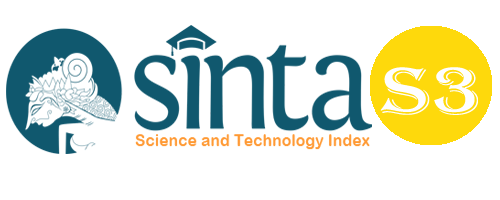SWOT Analysis Quick Response Indonesian Standard (QRIS) As a Digital Payment System (Cashless) Towards Advanced Indonesia
Abstract
Bank Indonesia together with the Financial Services Authority officially launched the Quick Response Indonesian Standard (QRIS) for the first time at the Bank Indonesia head office on August 17, 2019 and has been effective nationally since January 1, 2020. The SWOT analysis in this study aims to see the identification of problems found from the use of this QRIS digital payment system. IFAS and EFAS calculations are carried out in obtaining the number of points for each SWOT element by determining the coordinates of the SWOT Analysis Graph using a Cartesian Diagram. Based on the results of the research, the conclusion states that the results of Strength (QRIS Strength) are 1289 Points (37.2%), Weakness (QRIS Weaknesses) are 277 Points (8%), Opportunity (QRIS Opportunity) is 1284 points (37.1%) and Threat (QRIS Threat) as much as 610 points (17.6%). The final result of the study proves that the QRIS digital payment system is very feasible to use because the results of the SWOT analysis graph depicting the coordinates (X and Y) are located in the (Strength and Opportunity) section with the acquisition of the coordinates (X, Y) of (1012, 674). This means that Strength QRIS far outperforms 1012 points compared to Weakness QRIS and Opportunity QRIS outperforms 674 points compared to Threat QRIS, thereby proving that the community agrees and supports the use of the Quick Response Indonesian Standard (QRIS).
Keywords
Full Text:
PDFReferences
A. Almira and J. Sutanto. (2010 ).“Wasito Tririno Raharjo, FT UI, 2010,” pp. 8–27.
BABM Strategies, A. Swot, and DAN Porter. (2010). “Strategies to improve..., Wasito Tririno Raharjo, FT UI, 2010,” pp. 8–27, [Online]. Available: http://lib.ui.ac.id/file?file=digital/131608-T 27554-Strategies to improve-Literature review.pdf
DP Nathanael.(2019) "Analysis of Methods and Application of Digital Watermarking Concepts in QRIS (Quick Response Code Indonesia Standard).
ET Kurniawati, I. Zuhroh, and N. Malik. (2021). "Literacy and Education of Non-Cash Payments Through the Indonesian Standard QR Code (QRIS) Application in the Millennial Group,"Studs. Inov's case. icon., vol. 05, no. 01.
H. Sciences. (2016). “Cartesian Diagrams,” vol. 4, no. 1, pp. 1–23.
HA Ningsih, EM Sasmita, and B. Sari. (2021). "The Influence of Perceived Benefits, Perceived Ease of Use, and Perceived Risk on Decisions to Use Electronic Money (QRIS) in Students,"J. IKRA-ITH Ekon., vol. 4, no. 1, pp. 1–9.
Haerawan and YH Apprentice. (2019)."Marketing Household Appliances at Pt Impressindo Karya Steel Jakarta-Pusat,"science. manaj. Business, vol. 5, no. 2, pp. 175–189.
I. Payments and B. Education. (2020). "Implementation of e-payment qris on the information system for payment of education fees at integrated Islamic junior high schools, Sukabumi independent people,".
IWA Setiawan and LP Mahuni. (2020)."Qris in the Eyes of Umkm: Exploration of Umkm's Perception and Intention Using Qris,"E-Journal Ekon. and Business Univ. Udayana, vol. 10, p. 921, doi:10.24843/eeb.2020.v09.i10.p01.
JE Sihaloho, A. Ramadani, and S. Rahmayanti. (2020). "Implementation of the Indonesian Standard Quick Response Payment System for the Development of MSMEs in Medan,"J. Manaj. Business, vol. 17, no. 2, p. 287, doi:10.38043/jmb.v17i2.2384.
L. Vinet and A. Zhedanov.(2011). “A 'missing' family of classical orthogonal polynomials,”J. Phys. A Maths. theory., vol. 44, no. 8, pp. 1689–1699, doi: 10.1088/1751-8113/44/8/085201.
LS Musianto. (2002) "The Difference between a Quantitative Approach and a Qualitative Approach in Research Methods,"J. Manaj and Entrepreneur, vol. 4, no. 2, pp. 123–136, doi:10.9744/jmk.4.2.pp.123-136.
OB Saputri. (2020)."Consumer Preference in Using the Quick Response Code Indonesia Standard (QRIS) as a Digital Payment Tool,"Journals Econ. Buses. Mulawarman, vol. 17, no. 2, pp. 237–247.
RA Nasution. (2021). "Analysis of Traders' Perceptions on the Use of Qris as a MSME Transaction Tool in Medan City,"J. Chem. inf. Model., p. 95, [Online]. Available: http://dspace.ucuenca.edu.ec/bitstream/123456789/35612/1/Trabajo de Titulacion.pdf%0Ahttps://educacion.gob.ec/wp-content/uploads/downloads/2019/01/ GUIA-METODOLOGIC-EF.pdf
Rusdiansyah. (2016). "Analysis of Billing Application Strategies with the SWOT Method,"Build Insa. IT J., vol. 3, no. 1, p. 39843007.
SN Faizani and AD Indriyanti. (2021). “Analysis of the Effect of Technology Readiness on Perceived Usefulness and Perceived Ease of Use on Behavioral Intention from the Quick Response Indonesian Standard (QRIS) for Digital Payments (Case Study: Users of the Go-Pay e-Wallet Application, DANA, OVO, ”J. Emerg. inf. …, vol. 02, no. 02, pp. 85–93, , [Online]. Available: https://ejournal.unesa.ac.id/index.php/JEISBI/article/view/39738
Shah, M. et al. (2020). The Development Impact of PT. Medco E & P Malaka on Economic Aspects in East Aceh Regency. Budapest International Research and Critics Institute-Journal (BIRCI-Journal). P. 276-286.
WP Wind. (2021). The Effectiveness of Using Google Forms to Collect Student Assignments During the COVID-19 Pandemic.
DOI: https://doi.org/10.33258/birci.v5i1.4441
Article Metrics
Abstract view : 304 timesPDF - 204 times
Refbacks
- There are currently no refbacks.

This work is licensed under a Creative Commons Attribution-ShareAlike 4.0 International License.

This work is licensed under a Creative Commons Attribution-ShareAlike 4.0 International License.

_.gif)

















_.gif)



